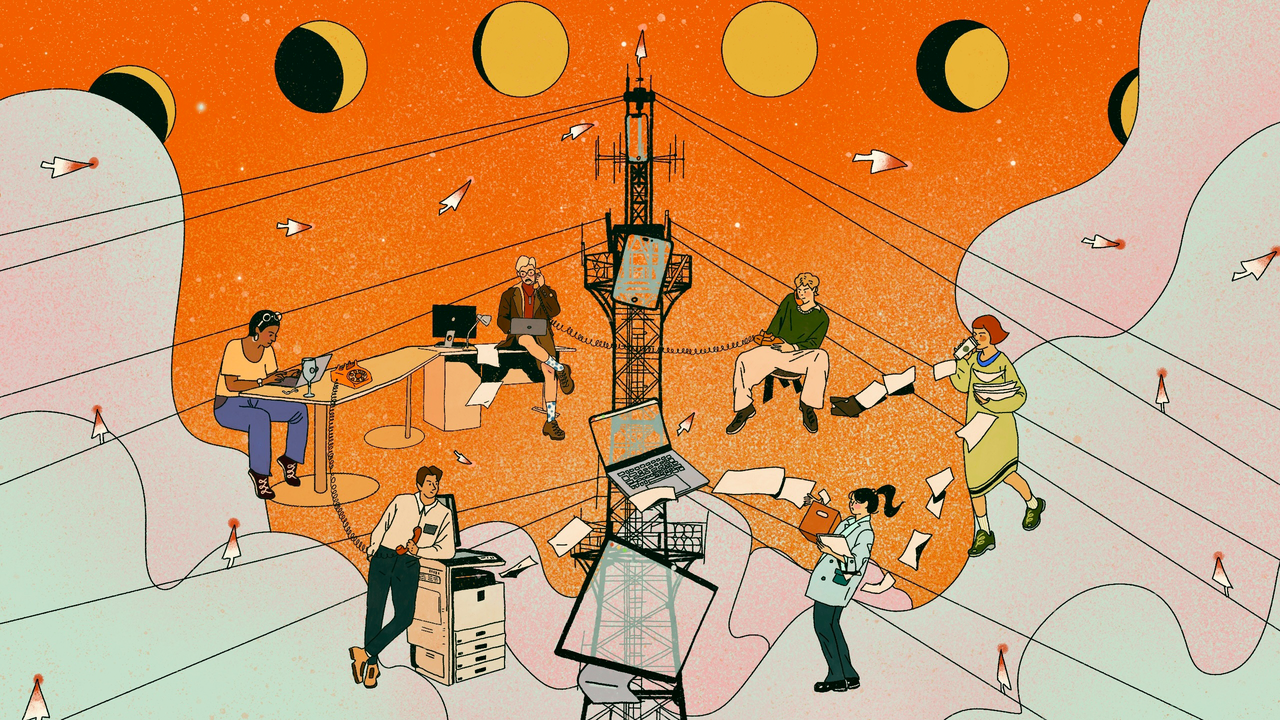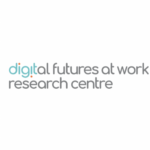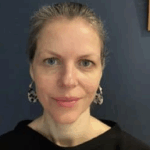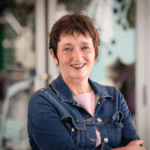 Yutong Liu & Digit / Digital Nomads Across Time / Licenced by CC-BY 4.0
Yutong Liu & Digit / Digital Nomads Across Time / Licenced by CC-BY 4.0
By Gemma Smith and Jacqueline O’Reilly
How are digital technologies and AI changing our working lives?
A quick internet search on this topic will usually produce images of smiling, or perplexed, people looking into a computer. Often these people are surrounded by an array of intimidating holograms associated with spatial computing that barely yet exist in our real working lives. In many cases, images of a white, male hand – one finger extended – meets the elegant finger of a white, humanoid robot. But this is not what really happens at work.
Does it matter that the existing images are so unrealistic?
We know that visualising the future is hard, because we’ve used some of these images at the Digit Centre ourselves in the past. Ubiquitous clichés are not harmless. The pioneering work of “Better Images of AI” (BIoAI) has highlighted, how these tropes constrain and distort the visual language available to help us think through the real challenges surrounding the advent, adoption and uses of AI at work, the core focus of Digit research. They also reflect inherent biases that exclude large communities that are not employed in a white, male corporate world. Images need to reflect the myriad of ways diverse communities are using these in their daily and working lives.
To address some of these gaps in our visual understanding and to help understand how we communicate the findings from our academic research, we launched a competition, in partnership with Better Images of AI. We asked artists to create new images of the digital transformation of work, inspired by our ESRC funded report on “Digital Dialogues: Shaping the digital transformation of work”.
Mobilising insights from our research
The Digital Dialogues report, summarising findings from our initial five-year research programme at Digit, shows some of the ways work is already changing with the introduction of AI and new digital technologies. It highlights the key challenges we need to address around patchy digital adoption, experimentation and patterns of exclusion, so that the social and economic opportunities of the digital transformation can be more widely and equitably shared.
However, the real-world changes we documented were not easily illustrated by the range of stock imagery currently available. This isn’t just our problem. It matters because free stock images are widely used by academics, research organisations, students, businesses and government departments. The prevailing stock imagery distorts communications with unhelpful metaphors that do not foster the digital dialogues we need between users, adopters and those struggling to keep up in this transformation.
Better Images of AI, have been doing incredible work to challenge and change the visual language used to discuss Artificial Intelligence through their free image library. By partnering with them we wanted to inspire new visual language that could ignite discussion about the nature of digital adoption, changes to employment contracts and working conditions, and issues of digital exclusion. By using this experimental approach to communicating insights from our academic research, we aimed to reach and influence a wider community of people affected by these changes.
Illustrating different facets of the digital transition
Our competition resulted in over 70 entries from across the world. An international panel of judges – including artists, designers, sociologists, lawyers, and informatics specialists, with members from the business, trade union and policy communities – helped us assess the entries.
The winning imagery, created by a range of talented professional and non-professional artists, beautifully illustrated our research findings with a new visual language.
In the overall winning image, Yutong Liu, highlights the ways that digitalisation facilitates connections between workers across time and place. It can bring new freedom and opportunities, but she also hints at some of the tensions associated with this new global connectivity.
Janet Turra (a joint winner) highlights a growing concern about the impact that AI may have on the skills threshold for entry-level jobs, making life tough for those just starting out in the workplace. This reflects findings from our research with creative and digital SMEs in Brighton, where it seems that, counterintuitively, middle-aged workers are better placed to experiment and make use of new generative AI tools.
Our research has also shown that adoption of AI has so far been quite patchy and uneven. IceMing (a joint winner) draws on the concept from Emily M Bender and colleagues of “stochastic parrots” highlighting this experimental approach to using AI tools at work. Some of the parrots are tethered, indicating that they are being controlled by the prompt authors, while others have more autonomy. This illustrates both the creative ways we can use AI, with varying levels of control, to help develop new imaginaries. It also recognises the critiques of hallucinating and providing poor or inaccurate summaries of well-established knowledge.
Another important theme was digital inclusion. Julieta Longo (a joint runner-up) cleverly illustrates the possibilities, the risks and the load that digitalisation can represent for care givers and platform workers. Her work beautifully illustrates the various connections many online workers, and others, have in multiple job holding. It brings to the fore the tensions inherent in using the internet as a way of combining income streams to maintain a fragile sense of stability in a complex nexus of dependent relationships.
While the ubiquity of devices implies inclusion, Nadia Nadesan’s work (a joint runner-up) shows how difficult it can be for those with fewer resources and out of date devices to access the online world and associated jobs, skills and services.
New image bank
This art project was an interdisciplinary experiment that we weren’t sure would work. It was open to anyone aged over 18 regardless of status, ability, nationality or artistic background. We were delighted by the high level and quality of submissions received. It revealed an enormous appetite to address the massive gap between understanding how these technologies are changing our lives, and how they are
visually represented and imagined.
Deciding collectively with our judging panel on the winners was not easy, but after extensive discussions we are pleased to award ten prizes. Many of these images are now also freely available through the Better Images of AI library for all to use, under the condition they cite the artists who produced them.
Collectively, these images prompt us to think more deeply about the multifaceted impacts of the digital transformation of work. They offer thoughtful, evocative and nuanced ways of seeing and imagining the realities of the digital transformation of work emanating from our research findings.
By collaborating to make them freely available through the Better Images of AI library, we hope they contribute to shaping the Digital Dialogues around the emergent digital work ecosystem its impact on our daily working lives.
Thank you to the wonderful artists who have made this possible. We hope you enjoy viewing them, sharing them and discussing what they mean in your communities.
Find out more
Access the Better Images of AI library
Read the news story about the winners
This blog was originally published by the ESRC Centre for Digital Futures at Work (Digit). Digit is an academic research centre providing critical insights into the digital transformation of work, jointly led by the Universities of Sussex and Leeds.

Digit (ESRC Digital Futures at Work Research Centre)

Gemma Smith
is the Research Communications & Impact Manager at the University of Sussex.

Gemma Smith
is the Research Communications & Impact Manager at the University of Sussex.

Jacqueline O’Reilly
is is Professor of Comparative Human Resource Management, University of Sussex.


